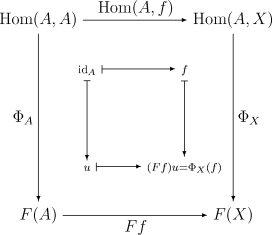User:Fropuff/Drafts/Hom functor
Definition
Let C be an locally small category and let Set be the category of sets. For each object A in C let Hom(A,–) be the hom-functor which maps objects X to the set Hom(A,X). A functor F : C → Set is said to be representable if it is naturally isomorphic to Hom(A,–) for some object A in C. A representation of F is a pair (A, Φ) where
- Φ : Hom(A,–) → F
is a natural isomorphism.
A dual set of definitions and statements apply to contravariant functors. A contravariant functor G : C → Set is said to representable if it is naturally isomorphic to the hom-functor Hom(–,A) for some object A in C.
Yoneda's lemma and universal elements
Recall that a natural isomorphism Φ from Hom(A,–) to F is determined by a family of bijections bijections ΦX : Hom(A,X) → F(X) making a certain set of diagrams commute. Define
The natural isomorphism is completely determined by φ since for each morphism u : A → X one has
One says that the functor F is represented by the pair (A, φ).
The representing pair (A,φ) is unique in the following sense. If (A1,φ1) and (A2,φ2) represent the same functor, then there exists one and only one isomorphism from A1 to A2 so that φ1 in F(A1) maps to φ2 in F(A2). This is because we have the isomorphisms Φ1:HomC(A1,-)→F and Φ2:HomC(A2,-)→F and so we have an isomorphism (Φ2)-1 o Φ1:HomC(A1,-)→HomC(A2,-). By the Yoneda lemma, A1 is isomorphic to A2 via the isomorphism determined by Φ1 and Φ2, and this maps φ1 to φ2. Uniqueness follows as everything is determined by φ1 and φ2.
Formal statement
Let C be a locally small category (i.e. the hom-sets of C are actual sets and not proper classes). For each object A of C let
be the hom-functor that sends X to the hom-set Hom(A,X).
Let F be an arbitrary functor from C to Set. Yoneda's lemma says that for each object A of C the natural transformations from hA to F are in one-to-one correspondence with the elements of F(A):
Given a natural transformation Φ from hA to F, the corresponding element of F(A) is
The proof of Yoneda's lemma is indicated by the the following commutative diagram:

This diagram shows that the natural transformation Φ is completely determined by u since for each morphism f : A → X one has
Moreover, any element u ∈ F(A) defines a natural transformation in this way.
The is a dual version of Yoneda's lemma that applies to contravariant functors from C to Set. Here one lets
be the contravariant hom-functor. The statement and proof are as above.
Let F : J → C be a functor with J small, and let Δ : C → CJ be the diagonal functor (i.e. Δ(X) : J → C is the constant functor to X). Then following statements are equivalent:
- (N, ψ) is a cone to F
- ψ is a natural transformation from Δ(N) to F
- (N, ψ) is a object in the comma category (Δ ↓ F)
The limit of F, a universal cone (L, φ) to F, is then nothing but a universal morphism from Δ to F, or a terminal object in (Δ ↓ F)
The dual statements are also equivalent:
- (N, ψ) is a cone from F
- ψ is a natural transformation from F to Δ(N)
- (N, ψ) is a object in the comma category (F ↓ Δ)
The colimit of F, a universal cone (L, φ) from F, is then nothing but a universal morphism from F to Δ, or an initial object in (F ↓ Δ)
Comma categories
comma category (T ↓ S)
- hom-set category (A ↓ B) = Hom(A, B) as a discrete category
- morphism (or arrow) category (C ↓ C) = C2
- (U ↓ A), objects U over A, or morphisms from U to A
- slice category, objects over A, written (C ↓ A) or C/A
- (Δ ↓ F) category of cones to F
- (A ↓ U), objects U under A, or morphisms from A to U
- coslice category, objects under A, written (A ↓ C) or A/C
- (F ↓ Δ) category of cones from F
Slice category
Let C be a category and let A be an object in C. The slice category is denoted (C ↓ A) or C/A.
- objects are morphisms to A in C, e.g. f : X → A
- morphisms are commutative triangles φ : (f : X → A) → (g : Y → A) with f = gφ
The forgetful functor, U : C/A → C, assigns to each morphism f : X → A its domain X. If C has finite products this functor has a right-adjoint which assigns to each space Y the projection map (A × Y → A). U then commutes with colimits.
Colimits
- If I is an initial object in C then (I → A) is an initial object in C/A.
- The coproduct of fX and fY is the natural morphism fX+Y.
Limits
- (idA : A → A) is a terminal object in C/A.
- Products in C/A are pullbacks in C.
Examples
- If A is terminal, then C/A is isomorphic to C.
- If C is a poset category, C/A is the principal ideal of objects less than A.
- Set/ℕ is the category of graded sets (morphisms must preserve the grade, so perhaps different than a multiset)







